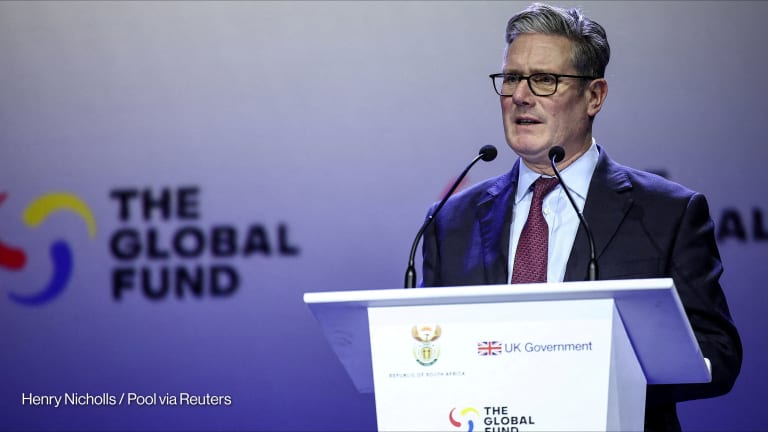What WHO can learn from different replenishment models
As WHO explores the feasibility of a replenishment model, one strength that might benefit the agency is its director-general’s access to heads of state. But to be successful, WHO must also find its "champions" and consider less traditional approaches.
In May, the 75th World Health Assembly agreed with an expert group recommendation for the World Health Organization to explore the feasibility of a replenishment model to increase its sustainable financing. The idea of a replenishment mechanism for WHO isn’t new, and the Independent Panel for Pandemic Preparedness and Response — which was set up by the United Nations agency in 2020 in response to a request made by the World Health Assembly — also recommended such a process to cover a third of WHO’s core budget. In addition to assisting in WHO’s quest for more sustainable financing, a replenishment model would provide resource predictability for the agency, with countries and organizations committing multiyear financing. This would complement an increase in assessed contributions — the annual fees paid by member states — that was decided during the 75th WHA. Experts who spoke to Devex identified some of WHO’s strengths that could help in establishing a replenishment mechanism and what the agency could learn from institutions that already have a replenishment approach, such as the Global Partnership for Education and the Global Fund to Fight AIDS, Tuberculosis and Malaria. There are various replenishment models, and each one is unique, said Dr. Christoph Benn, the director for global health diplomacy at the Joep Lange Institute based in Amsterdam. He has organized multiple replenishments for the Global Fund and has advised on other organizations’ replenishments as well. Benn said WHO will have to carefully assess the pros and cons of a replenishment. “A replenishment is not a magic wand, where suddenly the money appears on the table. It is a process that needs … to be tailor-made, and WHO would need a bespoke replenishment different from those of other organizations,” he said during a WHO event. Access to heads of state One strength unique to WHO is its director-general’s access to heads of state, Benn told Devex. That allows the WHO chief — a position currently occupied by Tedros Adhanom Ghebreyesus — to ask for support directly from the highest officials in government. “I wouldn't say that all previous DGs had the same kind of access to heads of state and government as Dr. Tedros has. But also certainly with the COVID[-19] pandemic being so high on the political agenda, it's very obvious. He's invited to all G-7 or G-20 meetings,” Benn said, referring to gatherings of the Group of Seven leading industrial nations and the Group of 20 major economies. That’s unlike the Global Fund, where Benn used to be director of external relations. “We had to fight hard to get access to G-7 [and G-20] meetings,” he said. “I don't see there being a lot of civil society organizations that are lined up to go out and campaign for big chunks of money to go to the [World Health Organization].” --— Aaron Oxley, executive director, RESULTS UK Country presence Also working to WHO’s advantage, according to Benn, is its country presence — something that’s missing at the Global Fund, which has to rely on advocates to campaign on its behalf within nations. This kind of capacity had to be built by the Global Fund over time, he said. Today, there are independent associations known as “friends” of the Global Fund in donor countries such as the U.S. and Japan, as well as in Europe. They help cultivate an understanding of the Global Fund’s mission in these places and mobilize support for the organization. A similar group, called Pacific Friends of Global Health, does the same thing in the Pacific region but focuses on Unitaid and Gavi, the Vaccine Alliance in addition to the Global Fund. “WHO can skip that step, in a sense, but it has to make its own representation in those countries more effective tools for advocacy and for building the support for budgetary decisions,” Benn said. Finding champions One of the key strengths of the Global Fund is its broad stakeholder engagement, according to Chris Collins, the president and CEO at the Friends of the Global Fight Against AIDS, Tuberculosis and Malaria. “When it's time for replenishment, there are people all over the world that are really willing to step up and urge their governments and other donors to make ambitious pledges,” he told Devex. The Global Fund has a significant base of support among civil society organizations, which advocates say links back to its structure. Civil society representatives and communities get to have a seat on the Global Fund’s board. They are also involved in country-level decision-making around funding and in implementing projects. While many civil society organizations see the need for providing resources to WHO and would like it to succeed, this doesn’t always translate to funding advocacy, said Aaron Oxley, the executive director of RESULTS UK. “I don't see there being a lot of civil society organizations that are lined up to go out and campaign for big chunks of money to go to the WHO,” he told Devex. So for WHO to have a successful replenishment, it would need to identify its “champions,” including in civil society. “We find ourselves in a fairly unique historical moment where there has never been a bigger need for the WHO to have the resources it needs to do its job,” Oxley said. “And there should be tons of champions that are able to say we need that global health piece from countries and from ministries.” Looking beyond traditional replenishments Most big multilateral health institutions focus their resource mobilization efforts on large pledging announcements from donor nations. That often dissuades low- and middle-income countries from making contributions, including those that could be donated to help build out their own health systems. But WHO could potentially look into this model as it considers replenishment approaches. At the Global Partnership for Education, low- and middle-income-countries announce pledges that are investments within their own borders, such as building schools or training teachers and increasing their salaries, according to Oxley. “What's interesting about that model is that, unsurprisingly, countries themselves end up pledging billions of dollars more than the donors do — which I think is quite powerful, because it reminds everybody that actually the people that are doing the most to address social challenges in low- and middle-income countries are not donors,” he said. This, Oxley added, illustrates the importance of encouraging low- and middle-income countries to make major investments in their own systems on a global stage — a lesson that could be useful for WHO, since much of its work relates to the strength of countries’ health systems. As for how the U.N. agency might take advantage of this model, “it's about … that complementary financing that countries are making their own investments that complement and support the roles that the WHO plays within the system,” he added.
In May, the 75th World Health Assembly agreed with an expert group recommendation for the World Health Organization to explore the feasibility of a replenishment model to increase its sustainable financing.
The idea of a replenishment mechanism for WHO isn’t new, and the Independent Panel for Pandemic Preparedness and Response — which was set up by the United Nations agency in 2020 in response to a request made by the World Health Assembly — also recommended such a process to cover a third of WHO’s core budget.
In addition to assisting in WHO’s quest for more sustainable financing, a replenishment model would provide resource predictability for the agency, with countries and organizations committing multiyear financing. This would complement an increase in assessed contributions — the annual fees paid by member states — that was decided during the 75th WHA.
This story is forDevex Promembers
Unlock this story now with a 15-day free trial of Devex Pro.
With a Devex Pro subscription you'll get access to deeper analysis and exclusive insights from our reporters and analysts.
Start my free trialRequest a group subscription Printing articles to share with others is a breach of our terms and conditions and copyright policy. Please use the sharing options on the left side of the article. Devex Pro members may share up to 10 articles per month using the Pro share tool ( ).
Jenny Lei Ravelo is a Devex Senior Reporter based in Manila. She covers global health, with a particular focus on the World Health Organization, and other development and humanitarian aid trends in Asia Pacific. Prior to Devex, she wrote for ABS-CBN, one of the largest broadcasting networks in the Philippines, and was a copy editor for various international scientific journals. She received her journalism degree from the University of Santo Tomas.








